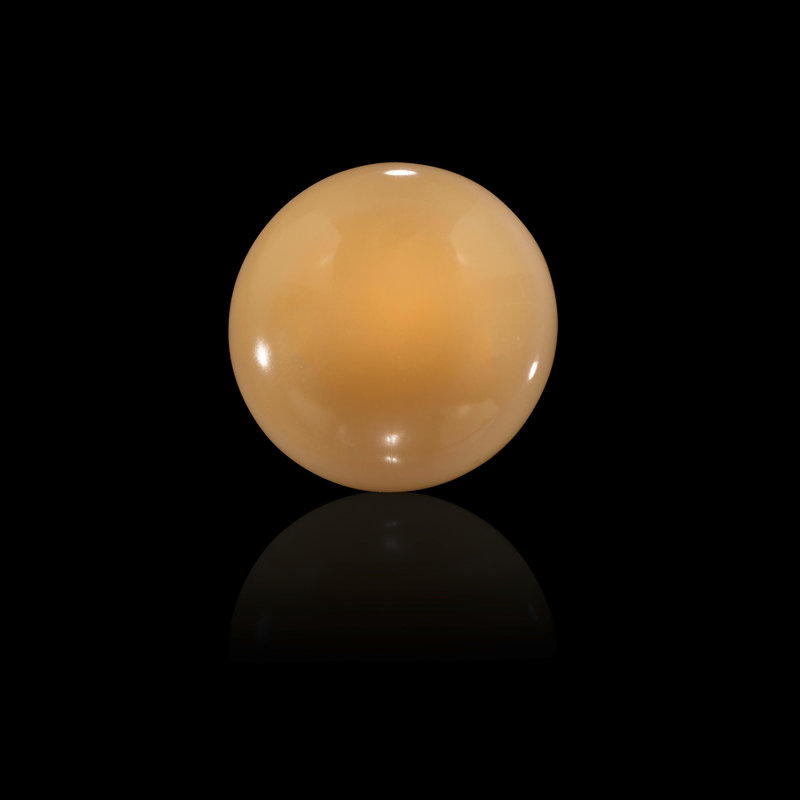Large Orange Non-Nacreous Pearl--"Melo Pearl", Melo melo volutidae, Saltwaters near Vietnam
Lot 3124. Large Orange Non-Nacreous Pearl--"Melo Pearl", Melo melo volutidae, Saltwaters near Vietnam. Weighing approximately 24.54 carats and measuring 16.60 x 11.65mm. Sold for US$31,875. © Bonhams 2001-2023
Relatively unknown in the West, even George Kunz's compendium of 1908, The Book of The Pearl, had no references to the rare orange pearls offered here. So few have been found, it is no wonder. The Melo melo is the marine snail that produces orange pearls the color of a ripe papaya. The snail generates a pearl-like substance to enclose foreign bodies, or irritants, entering its shell. Both orange and pink pearls (from the conch, Strombus gigas) are "non-nacreous", meaning they do not have a layer of calcium carbonate on their outer surface as white pearls do. Instead, they display a fiery, porcelain-like surface, giving them a unique beauty not possessed by other varieties of pearls. A relative of the conch, the Melo melo volutidae is also a gastropod. It is found in the waters of picturesque Halong Bay (meaning Bay of Dragons), along the northern coast of Vietnam.
Several thousand Melo volutes would have to be harvested for a single pearl to be found, particularly a fine quality pearl of any significant size. As the Melo volute is found in such deep waters almost 15 hours from the shoreline, although edible, it was not typically fished for food.
The Vietnamese Emperors valued the pearl highly and sent ships to search for the Melo shell. In the Pacific, the shell is regarded a sacred object by Buddhists, appearing in much religious imagery. The pearl was an expression of perfection in Buddhist thought as it requires no enhancement or alteration by man when it emerges from its shell, unlike gemstones which require faceting by man to reveal their beauty. The Chinese, Japanese and the Vietnamese all believed that pearls were created in heaven from droplets that fell from the Dragon in the sky. These droplets descended from heaven into open shells in the water. Moonbeams nourished the dragon droplets and these grew into pearls. It is no wonder that the Melo pearl has held a fascination in the East for centuries (Zucker, 1999).
The pearl was one of the eight precious emblems of the Buddha. As a sacred object, these pearls were never drilled or strung as beads. Instead they were used as objects of devotion. The "fiery pearl"— a pearl with a flaming tail and the Dragon are both ubiquitous in Vietnamese decorative arts, found in ceramics, textiles and painting. The Dragon, symbolizing the Emperor, is seen pursuing the pearl. The Emperors surrounded themselves with dragon and "flaming pearl" motifs in their art and even on their Imperial robes. One can now surmise that this was not just a metaphor but an illustration of the wonderful flame-like structure within the porcelain surface of the Melo pearl.
Perfection in form, the present bouton-shaped saltwater pearl has a porcellaneous surface on the dome, bottom and all sides. The delicate papaya orange color is even and show a minute flame pattern. Of suitable size for mounting as a ring or pendant.
Bonhams. FINE GEMS, OPALS, LAPIDARY ARTS AND NATURAL HISTORY, 17 May 2022, Los Angeles

/https%3A%2F%2Fprofilepics.canalblog.com%2Fprofilepics%2F1%2F0%2F100183.jpg)
/https%3A%2F%2Fstorage.canalblog.com%2F03%2F02%2F119589%2F96711876_o.jpg)
/https%3A%2F%2Fstorage.canalblog.com%2F11%2F31%2F119589%2F94773502_o.jpg)
/https%3A%2F%2Fstorage.canalblog.com%2F20%2F83%2F119589%2F94772815_o.jpg)
/https%3A%2F%2Fstorage.canalblog.com%2F26%2F72%2F119589%2F75604929_o.jpg)
/https%3A%2F%2Fstorage.canalblog.com%2F59%2F60%2F119589%2F26458628_o.jpg)



/http%3A%2F%2Fstorage.canalblog.com%2F25%2F84%2F119589%2F95564379_o.jpg)
/http%3A%2F%2Fstorage.canalblog.com%2F07%2F77%2F119589%2F95489873_o.jpg)
/http%3A%2F%2Fstorage.canalblog.com%2F29%2F76%2F119589%2F76086107_o.jpg)
/image%2F1371349%2F20240418%2Fob_ac5c4c_telechargement.jpg)